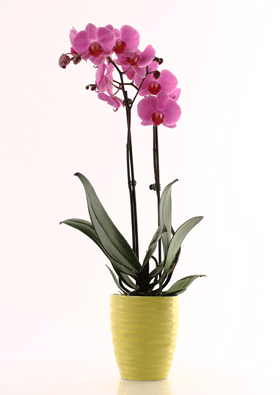 Phalaenopsis orchids can be planted in any container that provides adequate drainage and sufficient root ventilation, as long as an appropriate orchid-potting media is used. Many Phalaenopsis orchid owners prefer to double-pot their orchids. Potting orchids in a clear, plastic grower pot allows roots to be easily inspected without disturbing the plant. The grower pot can then be placed inside any decorative container.
Phalaenopsis orchids can be planted in any container that provides adequate drainage and sufficient root ventilation, as long as an appropriate orchid-potting media is used. Many Phalaenopsis orchid owners prefer to double-pot their orchids. Potting orchids in a clear, plastic grower pot allows roots to be easily inspected without disturbing the plant. The grower pot can then be placed inside any decorative container.
When double-potting orchids, make sure the decorative container provides appropriate drainage or allow the grower pot to drain thoroughly after watering before placing it in the decorative pot. With proper drainage, Phalaenopsis orchids will thrive in nearly any container; but plastic and clay pots are most common. Here’s how the two stack up:
- Plastic pots are cheap, light, and available in multiple sizes and colors. Many people prefer plastic over clay pots because they offer better water retention. Also, mineral salts and orchid roots will not stick to their smooth sides. Their light weight, however, can be a stability problem when Phalaenopsis orchids bloom.
- Clay pots offer good stability because of their weight, but their porosity can be both an advantage and disadvantage. Potting material dries faster in clay pots. While this can help keep orchid roots appropriately dry, it can also lead to over-drying. Orchids planted in clay pots should be closely monitored as they may need to be watered more frequently. Root attachment is another problem with clay pots. Phalaenopsis orchid roots tend to attach themselves to clay pots and can be nearly impossible to dislodge without breaking the pot or severing the root.
To learn more about potting orchids, visit our repotting webpage today. Phalaenopsis orchids can be planted in any container that provides adequate drainage and sufficient root ventilation, as long as an appropriate orchid-potting media is used. Many Phalaenopsis orchid owners prefer to double-pot their orchids. Potting orchids in a clear, plastic grower pot allows roots to be easily inspected without disturbing the plant. The grower pot can then be placed inside any decorative container.
Phalaenopsis orchids can be planted in any container that provides adequate drainage and sufficient root ventilation, as long as an appropriate orchid-potting media is used. Many Phalaenopsis orchid owners prefer to double-pot their orchids. Potting orchids in a clear, plastic grower pot allows roots to be easily inspected without disturbing the plant. The grower pot can then be placed inside any decorative container.